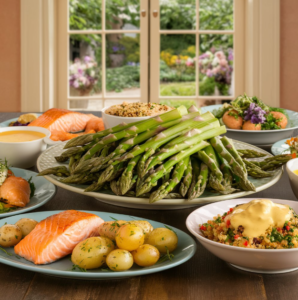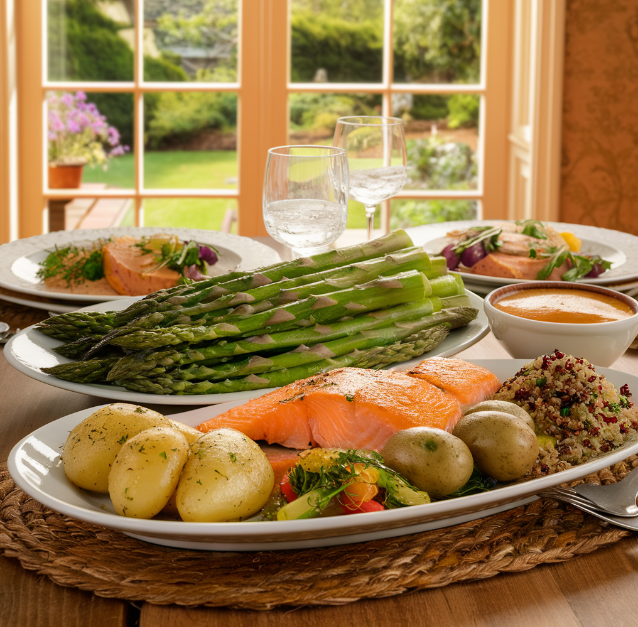https://www.health.com/nutrition/asparagus-health-benefits When it comes to crafting a delightful meal, the choice of side dishes plays a pivotal role, especially with a versatile vegetable like asparagus. This guide delves into the myriad of ways you can enhance your main dishes with asparagus, exploring everything from the best pairings to various cooking methods. Whether you’re planning a simple family dinner or a fancy gathering, understanding how to complement your meals with asparagus will surely elevate your culinary repertoire.
Introduction to Asparagus as a Side Dish
Asparagus, with its distinct flavor and impressive versatility, stands out as a favorite in kitchens around the globe. Not only does it bring a touch of elegance to the table, but it’s also packed with nutritional benefits, making it a superb choice for a healthy lifestyle. In this section, we’ll uncover the basics of asparagus as a side dish and why it’s so popular in various cuisines.
Understanding Asparagus
Asparagus is more than just a green vegetable; it’s a culinary delight that offers a unique blend of flavors, which can subtly enhance the main dish without overpowering it. Rich in fiber, folate, and vitamins A, C, and K, asparagus is not only good for your health but also your palate. Its spear-like stalks are tender when cooked properly, offering a slightly crispy, yet succulent texture.
Popularity in Cuisine
The popularity of asparagus across different cuisines can be attributed to its adaptability. It pairs wonderfully with a myriad of flavors, from the light zest of citrus to the rich umami of meats. Chefs and home cooks alike cherish asparagus for its ability to absorb and complement the flavors around it, making it a versatile choice for any meal. Whether steamed lightly and tossed with a bit of olive oil or roasted to caramelized perfection, asparagus brings a vibrant, healthful twist to any plate.
This introduction sets the stage for exploring the various dishes that pair beautifully with asparagus, ensuring that each meal is not only nutritious but also a feast for the senses. Stay tuned as we dive deeper into the perfect pairings and cooking methods that will allow you to make the most of this wonderful vegetable.
Best Main Dishes to Pair with Asparagus
Asparagus has a reputation for being a companionable side that melds well with an array of main dishes. Whether you’re leaning towards the ocean’s bounty or the comfort of poultry, understanding the synergy between asparagus and these proteins can elevate your dining experience. Here, we explore how asparagus complements various main courses, enhancing flavors and adding a nutritious balance.
Fish and Seafood Pairings
Asparagus and seafood are a match made in culinary heaven. The subtle, slightly grassy notes of asparagus complement the delicate flavors of fish wonderfully. For instance, grilled salmon with a side of lightly steamed asparagus is not just a meal; it’s a harmonious blend of flavors. The oily richness of salmon contrasts beautifully with the crisp freshness of asparagus, creating a balanced dish that’s both satisfying and light.
Other seafood like scallops, flaky cod, or even shrimp can also benefit from the presence of asparagus. Imagine pan-seared scallops with a side of asparagus sautéed in a bit of garlic; it’s simple yet profoundly flavorful. This pairing not only pleases the palate but also adds a splash of color and texture to your plate, making it as visually appealing as it is delicious.
Poultry Pairings
When it comes to poultry, asparagus is just as adept at complementing flavors. A classic roast chicken served with a side of roasted asparagus is a testament to the versatility of this green spear. The juiciness of the chicken enriched with herbs pairs splendidly with the earthy tones of asparagus, creating a meal that’s comforting yet elegant enough for any dinner party.
For a lighter option, consider chicken fillets or turkey breast steamed alongside asparagus, or for a more unique twist, try the Asparagus Stuffed Chicken recipe from FlashRecipes.
Beef and Other Meats
Asparagus also stands up well to the robust flavors of red meat. A juicy steak or a tender cut of beef can be enhanced with a side of grilled asparagus. The smoky char of the asparagus adds a new dimension to the meat, enriching the overall flavor profile without overpowering the main star of the dish.
Even with more economical cuts like braised beef or a hearty stew, asparagus can add a touch of refinement, bringing freshness and a bit of crunch to richer, heavier meals. This combination not only satisfies the taste buds but also ensures a balanced diet, making every meal a bit more special.
Through these pairings, asparagus Not only does it bring a touch of elegance to the table, but it’s also packed with nutritional benefits, making it a superb choice for a healthy lifestyle.


